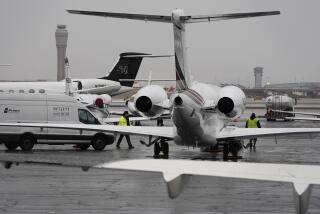AIRPORTS /USER FEES? : Plan Proposes Passengers Pay to Help Ease Gridlock at Gates
- Share via
WASHINGTON — Airline deregulation achieved the intended effect of getting more people to fly, but it also created a nettlesome side product: overcrowding on the ground and congestion in the air.
And the numbers just keep growing. According to figures compiled by the Air Transport Assn., 316 million passengers flew in 1979, the first year without heavy government regulation, compared with 454 million in 1989. Over the same period, the number of airplane departures soared from 5.4 million to 6.6 million a year.
Dallas-Ft. Worth Airport, the nation’s newest airport, was built in 1974 and is one of 21 airports choking with 20,000-plus hours of annual flight delays. By the time proposed airports in Denver and Austin, Tex., are added to the nation’s air transit system sometime during the middle of this decade, a dozen more airports will be gridlocked with the same level of congestion, according to projections by the Federal Aviation Administration.
PROPOSED SOLUTION: The obvious answer is to build more airport terminals and gates. But that’s easier said than done. Local communities can’t afford expensive capital projects; federal assistance for airport construction is a long-gone luxury. In addition, anti-noise community groups often pose formidable political opposition to construction proposals.
With the support of airport operators, the Bush Administration--via Transportation Secretary Samuel K. Skinner--has another idea. The suggestion: change federal laws prohibiting local airport authorities from charging passengers additional fees for using their facilities.
Under proposed legislation, airport authorities could seek permission from the transportation secretary to charge departing passengers a fee of $1, $2 or $3. These so-called Passenger Facility Charges--or PFCs--would be collected by the airlines and passed along to airport officials. The money generated could be used only for specific and pre-approved projects such as constructing new gates or, perhaps, a new airport as envisioned by officials in Chicago.
The legislation also would require the Administration to spend down the Airport Trust Fund, primarily to benefit small airports that would not be allowed to impose the user fees on passengers. The trust fund has a $7.6-billion surplus.
OUTRAGED OPPOSITION: Critics complain that PFCs are attractive only because they are hidden taxes. Among the most vocal opponents has been Rep. Norman Y. Mineta (D-San Jose), who considers the legislation a “needless tax, which is unfair to the traveling public.”
Despite some resistance, a PFC bill passed the House last month.
The Senate is about to take up the issue. Two key senators--Commerce Chairman Ernest F. Hollings (D-S.C.) and aviation subcommittee Chairman Wendell H. Ford (D-Ky.)--are on record opposing PFCs.
OUTLOOK: But even if the fees are implemented, limited airport capacity is likely to remain for the foreseeable future, according to a pair of General Accounting Office reports that supported the PFC legislation.
The GAO, in fact, found that many of the problems associated with expansion stemmed from agreements between airport authorities and carriers that gave carriers control over many decisions. For example, carriers may have exclusive rights to certain gates, and airport authorities may have to ask their permission to increase their fees for airport improvements.
The GAO pointed out that by creating independent funds, “a PFC could help shift more control over airport development, expansion and use decisions to airports.”
But that is still no guarantee that the PFCs would trigger new airport construction projects. Other factors, such as airport noise and airline marketing practices, inhibit airport expansion projects. Or stated another way, in the words of the GAO, “A PFC is not a panacea, as a lack of adequate funding is not the only problem faced by airports trying to expand capacity.”
More to Read
Sign up for Essential California
The most important California stories and recommendations in your inbox every morning.
You may occasionally receive promotional content from the Los Angeles Times.













